 |
F. Malcolm Benitz | Page last modified: |
 |
F. Malcolm Benitz | Page last modified: |
When Italy capitulated on September 8th, 1943, Malcolm (a Flying Officer in the RCAF-VR) was a P.O.W. in Italy, at P.G. 78 near Sulmona (east of Rome). He got away and walked south to the Allied lines, eventually meeting “a platoon of the Green Howards on recce” on October 13th. (For more details, see his diary for an account of his escape).
On October 14th, 1943, the day after Malcolm reached the Allied lines, he and 9 other escaped P.O.W.s were taken by lorry/truck to Foggia where he was debriefed by an Intelligence Officer. Following which he met with Army & RAF commanders in Lucera (20km west of Foggia) and wrote up a report. On the 15th he was taken to Termoli where nine days earlier the Allied counter-attack displaced the Germans who had taken it from the Canadians. On the 16th he was flown (in a Fairchild, a light aircraft) to Bari where he met with T.A.F. (Tactical Air Force) and Army commanders to plan an airdrop of arms and supplies to the Italian resistance (near Campo di Giove) and escaped POWs of P.G. 78 (his former P.O.W. camp east of Sulmona). T.A.F. overflew both places for 20 minutes on two successive days (Oct. 18 & 19) but saw no sign of life so did not make the drop – further attempts were then cancelled.
Malcolm had requested to go on one of the flights but was denied; however, T.A.F. did drop his message in a package containing cigarettes and chocololates at Campo di Giove. (When we visited in 2004, his gesture of thanks was remembered well by Dr. Torinto Sciuba's family – Dr. Sciuba had been instrumental in Malcolm’s escape.)
While waiting in Bari for the outcome of the drops, Malcolm borrowed money to buy Margaret Douglas cosmetics & stockings.
Margaret Douglas/Cooper: She was from "La Panchita", an estancia (ranch) in Córdoba (prov.), Argentina, a few kilometers south-west of Malcolm at "La California". Malcolm was sweet on her. When we visited her near Toronto, in 2011, she still remembered “those black stockings” given to her by Malcolm. For more about her, please see their letters when he was a P.O.W.
Following the aborted second drop, Malcolm was told on October 19th to report in with the Officer Commanding P.O.W. Distribution in Bari. He was flown back to England. He must have had a lay-over in Gibraltar because he spoke of the monkeys there.
Malcolm was in England for about a month, awaiting a decision by the RCAF about his future posting. Because he was an escaped officer, he would not be put back in the same front where he had been captured, i.e. Europe. He was kept busy with red tape, “parades”, and attending the investiture (see below) on Tuesday, November 16th, at Buckingham Palace when he received his D.F.C. from the king. Orders for his repatriation to Canada were issued the following week, on Tuesday, November 23rd. He had been promised a 30-day leave so that he could visit his home in Argentina, but it had not come through yet.
When in London, Malcolm stayed with Moll Hale (his step-mother’s sister – he adored her, she had taken care of him ten years earlier when he was attending school in England). Apparently her phone rang off the hook with calls from his POW friends asking after “Benny”. Flush with a year’s back-pay in his pocket, Malcolm was generously picking up the bar tabs – until Moll took away his money, restricting him to a nightly allowance, even patting him down to make sure he didn't have any extra hidden away.
He must have had a considerable amount of free time. He was still in England on Friday the 26th when he wrote Margaret Douglas that “On Sunday I met an amazing amount of Argentines at the Club...”, and “Several of our gang from Italy are here & we had a mild celebration last night.” (see his letter to her below)
Malcolm’s “trip to Buckingham Palace” is best described in his own words in a letter he wrote to Margaret Douglas:
The trip to Buckingham Palace was grand; the King was in very good form, & asked me several questions – They gave us the gen in the ante-room before hand & I damn nearly collapsed after the guy had gone through the procedure & ended up by saying – don't worry - as you will see what the fellow ahead does," & then he called my name to go first! However it turned out to be much quicker & easier than I’d expected. We waited for the decorations after we had gone up for ours & it took nearly 2½ hours. The King must have been a bit done in after doing about 350 or 400! Moll & Marjory came to support me – I wish you could have come too – We found Algy Bibby & George Daly outside when we came away. Both Algy & Bibby exactly the same as before. They went down to the Traills for three days & I saw them again on Sunday.
His citation, as recorded by the Air Force Association of Canada:
BENITZ, P/O Frank Malcolm (J15035) - Distinguished Flying Cross - No.104 Squadron - Award effective 7 April 1942 as per London Gazette dated 4 April 1942 and AFRO 611/42 dated 24 April 1942. Born in Buenos Aires, Argentina, 26 April 1917; home in Entasia [sic] La California, La California, Argentina; enlisted in Ottawa, 17 October 1940. Trained at No.1 ITS and No.10 EFTS. Graduated from No.5 SFTS, 10 April 1941. Commissioned October 1941. Medal presented 16 November 1943. Later prisoner of war.
One night in October 1941, this airman was the captain of an aircraft which carried out a raid on Naples. After a successful attack during which he remained over the target area for an hour, the port engine of his aircraft began to fail. Pilot Officer Benitz thereupon set course for his base but on making an inspection he discovered that several of his bombs still remained hung up. Although the defective engine was giving little power causing the aircraft to lose height, Pilot Officer Benitz changed course for an alternative target and finally released his remaining bombs over the heavily defended area of Palermo. By now the port engine had failed completely and the aircraft was flying at some 4,500 feet. Nevertheless, Pilot Officer Benitz headed the aircraft towards the coast in order to avoid the mountains and displaying fine airmanship he finally succeeded in reaching his base and landing safely. Throughout, this airman showed great courage and determination.
NOTE: Public Records Office Air 2/4782 has message dated 26 February 1942, RAFHQ Middle East to Air Ministry, with original recommendation which is more detailed. He was a Sergeant (R74280) and the award was to have been a Distinguished Flying Medal:
The above-named Non-Commissioned Officer was captain of an aircraft which attacked Naples on the night of October 31, 1941. After remaining at the target for an hour successfully attacking, it [suffered] loss of revolutions and overheating developed in his port engine. He set course for home but on making an inspection [he] discovered that several of his bombs had hung up. Although by this time his engine was giving little power he changed course for the alternative target, Palermo, which was off his route for the last 30 minutes of his Estimated Time of Arrival. He could not maintain height but he still carried on and dropped his bombs in the heavily defended target rather than jettison them into the sea. By the time this attack was over his height was only 4,500 feet and the port engine had completely failed. He fully feathered the airscrew and, turning to the coast to avoid the mountains in Sicily, brought his aircraft and crew home and made a successful landing at base. During the whole operation Sergeant Benitz showed the highest courage. His attack was pressed home with determination and his skill alone was responsible for the safe return of his aircraft.
|
London43-04 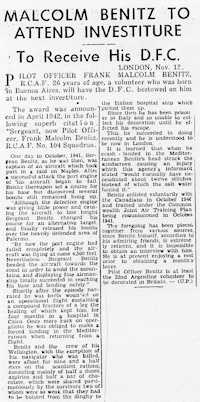
Buenos Aires Herald London43-07 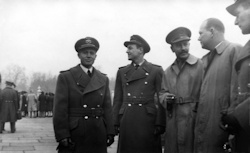
Buckingham Palace 16.11.43 |
London43-05 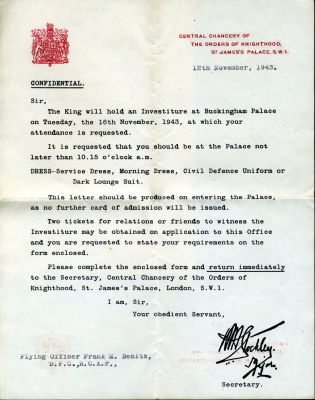
Invitation to Investiture London43-08 
Buckingham Palace 16.11.43 |
London43-06 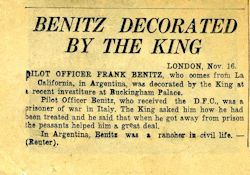
Buenos Aires Herald London43-09 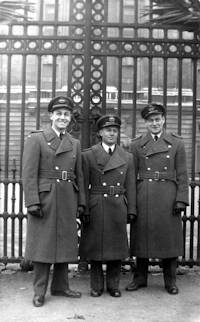
Buckingham Palace 16.11.43 |
Malcolm was granted 30 days leave clear – 30 days plus the days to travel between Canada & Argentina. He flew on Panagra (Panamerican Grace Airlines), stopping the night along the way in: Bermuda, Miami, Trinidad, Natal, Rio. He arrived on the 23rd of December at Palomar, then a civilian airport in the suburbs west of Buenos Aires. His sister Moyra joined him in Argentina, sailing from England. It was summer in the southern hemisphere, probably a welcome relief from the cold north.

The Standard – 24 Dec. 1943 |
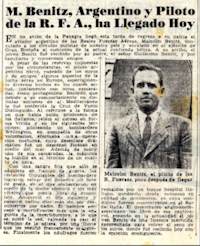
La Razon – Dec. 1943 |
The photos below were all taken at “La California” (the Cali ), the family estancia (ranch) 450 km. north of Buenos Aires in Santa Fé province. Except for the first row of aerial views, they were taken over Christmas and New Year, 1943. Malcolm may have taken some of the rectangular photos (e.g. Daphne Willans) for their dimensions are similar to those he took later in Canada. Unless specified otherwise, all the photos are from Malcolm’s vizcacha (i.e. rat-pack) files.
The aerial views were taken in winter (May – September, most likely 1943) – the paraiso (Chinaberry) trees, which are deciduous, have no leaves.
On Januray 22, 1944, Malcolm was posted to "Y" Depot (a manning depot), probably in Toronto, Ontario – indicating he had returned from Argentina. Two months later, on March 16, he was posted to No.16 SFTS (Service Flying Training School) near Hagersville, Ontario. The school was equipped with Harvard (single engine) and Avro Anson (twin engine) trainer aircraft – we assume then that he was being retrained (possibly because he had not flown since November, 1942).
On May 11, 1944, Malcolm was posted to No.164 Transport Squadron’s base in Edmonton, Alberta. Squadrons 164 and 165 were the primary source of crews and aircraft for airlift within Canada. The squadrons were equiped with twin-engined aircraft: Lockheed Lodestar (C-60A) and Douglas Dakota (C-47). They carried passengers military and civilian (including eskimos), paratroopers on practice jumps, and freight of all kinds (fuel & aircraft parts) resupplying the airfields of the Northwest Staging Route to Alaska and Russia.
Malcolm flew transport in northern Canada for almost a year (May 11, ’44 – March 31, ’45). He enjoyed Canada, but winter conditions were particularly harsh (see below his postcard to cousin Frank Watt, an RAF pilot). When on the ground, the engines were drained of oil and enclosed in tents. Both oil and engines were kept warm wih fire-burning braziers to keep them from freezing. However, once the oil was put back in the engines, there was no time to test flaps, etc. before the engines froze so take-off was almost immediate.
While in northern Canada, Malcolm bought himself a heavy Eskimo sweater made of unwashed wool – the natural oils in the wool repelled water – until years later, in Argentina, when he wore it when camping; Gertie (his wife) saw that it was greasy & dirty and washed it in detergent!!
On March 31, 1945, Malcolm was posted from No.164 Transportation Squadron (at Edmonton, Alberta) to Y Depot (holding, likely at Toronto). Two week later April 13, he was posted overseas (i.e. from Canada to England), likely in anticipation of being placed in a bomber squadron.
Germany capitulated on May 9, 1945, the same day Malcolm reported for training on the Avro Lancaster (likely at RCAF No. 6 Aircrew School, at Topcliffe near Thirsk, Yorkshire – his notes are not clear, see notebook below). He mentions the engines (Merlin 28) and carburattors (Bendix-Stromberg) with which the Lancasters were equiped – which suggest he was training on a long range version of the Lancaster (the “BIII (F/E)”, or the “X” manufactured in Canada) for ops in the Far East, including Japan.
Malcolm was repatriated to Canada on August 2, 1945; the same month in which long range Lancasters were flown to Canada in preparation for ops in the Far East.
On August 6 and 9, the U.S. dropped atomic bombs on Hiroshima and Nagasaki, killing an estimated 40,000 people. On August 15, Emperor Hirohito announced Japan’s unconditional surrender. Malcolm believed those bombs saved his life – in his estimation, the Lancaster lacked sufficient armament to fend off attacks by Japanese Zeros.
© Peter Benitz (Benitz Family)